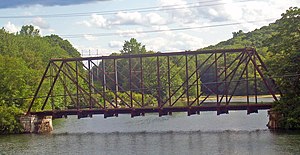Bridge L-158
Coordinates: 41 ° 17 ′ 47 " N , 73 ° 40 ′ 57" W.
| Bridge L-158 | ||
|---|---|---|
| View of the bridge from New York State Route 138 | ||
| Convicted | derelict New York Central Railroad | |
| Subjugated | Muscoot Reservoir | |
| place | Goldens Bridge , NY , USA | |
| Entertained by | New York City Department of Environmental Protection | |
| construction | double crossed Whipple truss made of wrought iron | |
| overall length | 49 m | |
| width | 4.8 m | |
| height | 3.5 m | |
| completion | Published in 1883, 1904 | |
| location | ||
|
|
||
Bridge L-158 is a disused railroad bridge over the Muscoot Reservoir near Goldens Bridge , New York in the United States. It served the New York Central Railroad route from Goldens Bridge to Lake Mahopac .
The bridge was originally built to carry railroad trains of the New York Central and Hudson River Railroad over Rondout Creek near Kingston . The iron bridge was moved to its current location in 1904.
The structure has been idle since 1960 and the rails have been removed. It is the only remaining double-crossed Whipple truss railroad bridge in New York. It was listed on the National Register of Historic Places in 1978 and is the only bridge structure entirely in Westchester County on the register.
location
The bridge runs over a bay of the reservoir, about one kilometer west of Goldens Bridge station on the Metro-North Harlem Line and Interstate 684 , on the border between the Towns of Lewisboro in the east and Somers in the west. The New York State Route 138 crosses the reservoir about 150 meters further north.
The area around the bridge is overgrown with woodland that is part of the water conservation area that surrounds the reservoir, and all of this, like the bridge itself, belongs to the New York City Department of Environmental Protection . The course of the former railway line can still be seen on both sides of the bridge.
Building
Both trusses are 49 m long and consist of nine identical fields. The grid is 9.6 m deep. The bridge is located on two abutments made of concrete , about 3.5 m above the mean water level.
The Phoenix columns and the upper band as well as the supports of the structure connected with bolts are made of wrought iron in the upper area . The posts at the end and the top band are connected with six flanged cast iron elements that are riveted together . The intermediate vertical posts and the lateral struts each have four connecting elements.
history
The bridge was originally the smallest of three spans of a 360 m long viaduct on the important New York – Albany “West Shore Line” railway at the mouth of Rondout Creek in Kingston . That structure was built in 1883 by Clarke, Reeves & Company, a subsidiary of the Philadelphia-based Phoenix Iron Works . The original structure was three feet wide, ran two tracks across the river and was listed as Bridge 141 on the New York Central Railroad .
Around 1904, the New York City government began buying, clearing, and damming land in the Croton River basin to keep the city water supplies . According to the agreement with the city, the railway companies were obliged to bridge flooded areas at their own expense. The railway company therefore had a new bridge built on Rondout Creek in 1904, which could bridge the river as a whole with a single main span.
The NYC decided to move parts of bridge number 141 some eighty kilometers further south and reuse them on the new reservoir, where it now served as the L-158 bridge for the branch line to Mahopac of the former New York and Harlem Railroad . This branch line, originally built by the New York and Mahopac Railroad , was used to connect a summer holiday resort in the 19th century. Because it was only a single-track line, the bridge was rebuilt with a reduced width of 4.9 m.
The traffic on the branch line to Mahopac continued until 1960. The tracks were finally dismantled, but the bridge itself remained standing. In 1976, a scouting team for the Historic American Engineering Record found it to be in good shape other than lack of use and maintenance. Its location on land used for New York City's water supply, to which access is severely restricted, has also facilitated its historical preservation.
See also
supporting documents
- ↑ a b c d e f Raymond Smith: National Register of Historic Places nomination, Bridge L-158 ( English ) New York State Office of Parks, Recreation and Historic Preservation . May 16, 1978. Archived from the original on June 12, 2012. Info: The archive link was automatically inserted and has not yet been checked. Please check the original and archive link according to the instructions and then remove this notice. Retrieved April 25, 2012.
Web links
- Bridge L-158 . Report on the Historic American Engineering Record

